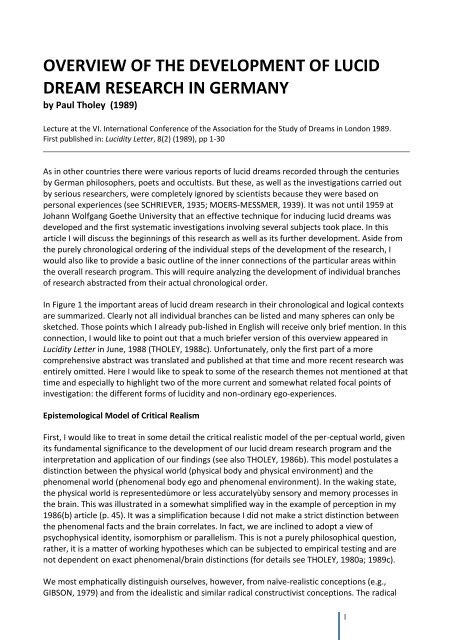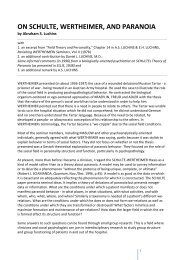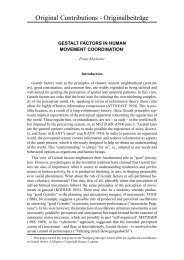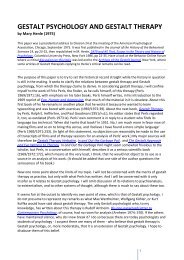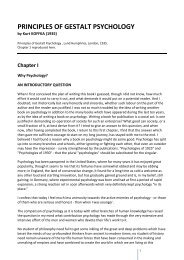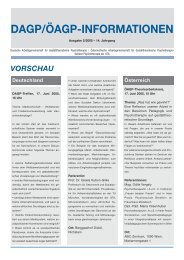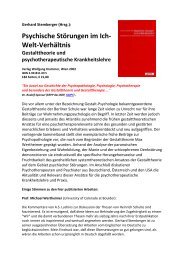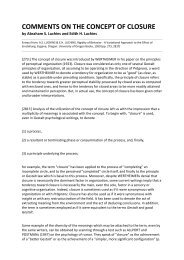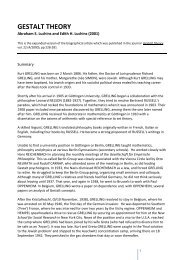pdf-Download - Society for Gestalt Theory and its Applications (GTA)
pdf-Download - Society for Gestalt Theory and its Applications (GTA)
pdf-Download - Society for Gestalt Theory and its Applications (GTA)
You also want an ePaper? Increase the reach of your titles
YUMPU automatically turns print PDFs into web optimized ePapers that Google loves.
OVERVIEW OF THE DEVELOPMENT OF LUCIDDREAM RESEARCH IN GERMANYby Paul Tholey (1989)Lecture at the VI. International Conference of the Association <strong>for</strong> the Study of Dreams in London 1989.First published in: Lucidity Letter, 8(2) (1989), pp 1-30As in other countries there were various reports of lucid dreams recorded through the centuriesby German philosophers, poets <strong>and</strong> occultists. But these, as well as the investigations carried outby serious researchers, were completely ignored by scientists because they were based onpersonal experiences (see SCHRIEVER, 1935; MOERS-MESSMER, 1939). It was not until 1959 atJohann Wolfgang Goethe University that an effective technique <strong>for</strong> inducing lucid dreams wasdeveloped <strong>and</strong> the first systematic investigations involving several subjects took place. In thisarticle I will discuss the beginnings of this research as well as <strong>its</strong> further development. Aside fromthe purely chronological ordering of the individual steps of the development of the research, Iwould also like to provide a basic outline of the inner connections of the particular areas withinthe overall research program. This will require analyzing the development of individual branchesof research abstracted from their actual chronological order.In Figure 1 the important areas of lucid dream research in their chronological <strong>and</strong> logical contextsare summarized. Clearly not all individual branches can be listed <strong>and</strong> many spheres can only besketched. Those points which I already pub-lished in English will receive only brief mention. In thisconnection, I would like to point out that a much briefer version of this overview appeared inLucidity Letter in June, 1988 (THOLEY, 1988c). Un<strong>for</strong>tunately, only the first part of a morecomprehensive abstract was translated <strong>and</strong> published at that time <strong>and</strong> more recent research wasentirely omitted. Here I would like to speak to some of the research themes not mentioned at thattime <strong>and</strong> especially to highlight two of the more current <strong>and</strong> somewhat related focal points ofinvestigation: the different <strong>for</strong>ms of lucidity <strong>and</strong> non-ordinary ego-experiences.Epistemological Model of Critical RealismFirst, I would like to treat in some detail the critical realistic model of the per-ceptual world, given<strong>its</strong> fundamental significance to the development of our lucid dream research program <strong>and</strong> theinterpretation <strong>and</strong> application of our findings (see also THOLEY, 1986b). This model postulates adistinction between the physical world (physical body <strong>and</strong> physical environment) <strong>and</strong> thephenomenal world (phenomenal body ego <strong>and</strong> phenomenal environment). In the waking state,the physical world is representedùmore or less accuratelyùby sensory <strong>and</strong> memory processes inthe brain. This was illustrated in a somewhat simplified way in the example of perception in my1986(b) article (p. 45). It was a simplification because I did not make a strict distinction betweenthe phenomenal facts <strong>and</strong> the brain correlates. In fact, we are inclined to adopt a view ofpsychophysical identity, isomorphism or parallelism. This is not a purely philosophical question,rather, it is a matter of working hypotheses which can be subjected to empirical testing <strong>and</strong> arenot dependent on exact phenomenal/brain distinctions (<strong>for</strong> details see THOLEY, 1980a; 1989c).We most emphatically distinguish ourselves, however, from naïve-realistic conceptions (e.g.,GIBSON, 1979) <strong>and</strong> from the idealistic <strong>and</strong> similar radical constructivist conceptions. The radical1
constructivists confuse the critical-phenomenal conception of the physical world with the physicalworld <strong>its</strong>elf. The <strong>for</strong>mer is constructed on the basis of perception <strong>and</strong> thought, <strong>and</strong> frequentlychanges; whereas the latter obeys unchanging natural laws. A naïve-realistic model has especiallynegative consequences with respect to research <strong>and</strong> practice in the field of lucid dreaming <strong>and</strong> therelated field of out-of-body experiences (OBEs). It not only hampers research, but <strong>for</strong> people whomisinterpret such experiences it can have very dangerous consequences, possibly leading toserious mental disorders.Just as the perceived world can provide us with in<strong>for</strong>mation about physical reality despite themany deceptions <strong>and</strong> illusions, the dream world can present us with in<strong>for</strong>mation about ourpsychological reality (the psychological person <strong>and</strong> his or her psychological situation), despitesymbolic distortions. In general, we take the term "reality" to mean simply anything that has aneffect. Accordingly, we underst<strong>and</strong> psychological reality to mean the totality of that which canhave an effect on our experience <strong>and</strong> behavior (see LEWIN, 1936). This would especially includethe so-called unconscious facts which we can conceptualize as psychological constructs <strong>and</strong> whichcan basically be replaced by physiological concepts at a later time.Here we are in agreement with FREUD that dreams are the "royal road" to the unconscious. Butthis is of little help when, in the orthodox psychoanalytic sense, normal dreams are experiencedwith a hazy consciousness <strong>and</strong> the absence of an ability to act. Or after waking when we report toa biased psychotherapist about our even more hazy <strong>and</strong> distorted observations <strong>and</strong> theassociations connected to them.In order to gain insight into our psychological problems <strong>and</strong> resolve them, it is much moreimportant to interact with the symbolic world in a way enabled by lucid consciousness <strong>and</strong> theconsequent greater freedom of action. Just as we can interact with physical reality in a wakingstate by means of the sensory-motor feedback system, we are capable of taking action in thepsychological reality of lucid dreams due to the reciprocal reactions between the symbolic events<strong>and</strong> the underlying psychological processes. These fundamental principles have provided the basicunderpinnings guiding our investigations into lucid dreaming. The results of the research haveshown them to be extremely sound in practice.But now let us turn to the epistemological considerations described in the article written <strong>for</strong>Lucidity Letter in 1986, in which I focused exclusively on the process of perception. I alsoemphasized that it was an underst<strong>and</strong>ing of the critical realistic model which first brought me tothe idea of developing a method <strong>for</strong> inducing lucid dreams, a method I will only briefly describe.Techniques <strong>for</strong> Lucid Dream InductionThe Reflection TechniqueWhen I recognized that the objective - <strong>and</strong> intersubjective -appearing perceptual world wasmerely a phenomenal world, it occurred to me to compare this phenomenal waking world withthe dream world through systematic observation. The dream world is, in fact, a phenomenalworld. But, being less dependent on sensory stimulation, it is possible <strong>for</strong> events to transpirewhich are not possible with normal perception in a waking state. Such unusual events made itpossible <strong>for</strong> me to recognize the dreaming state.2
On the basis of these ideas, I developed my first technique <strong>for</strong> inducing lucid dreams in 1959. Icalled it the "Reflection Technique." Using this technique, the subject asks him or herself severaltimes during the course of the day: "Am I awake, or am I dreaming?" The purpose is to achieve agenerally critical attitude towards one's state of consciousness. When confronted with unusualexperiences, this facilitates recognition of the dreaming state.After four weeks I had my first lucid dream. I recognized that I was dreaming because I saw anaunt whom I knew to have been dead <strong>for</strong> some time. Since I was not at all acquainted with suchphenomena at that time, I was at first fascinated by this new experience. Later, however, I wasseized by a kind of claustrophobic feeling because I did not know how or whether I would be ableto get out of this dream world. I finally woke up after staring at a flower in the dream environmentuntil the flower <strong>and</strong> the entire surroundings became blurred.PRICE <strong>and</strong> COHEN (1988), who refer to only one of my articles translated into English, havereferred to the reflection technique as the development of an active attitude. With respect to theearly application of the technique this is correct. A process of active questioning, however,ultimately gives rise to a passively receptive focus on current experience which, in turn, makes theposing of critical questions a superfluous matter. In other words, increased practice helps developthe disposition making it possible to recognize the dreaming state when triggered by unusualevents.A first important goal in improving the effectiveness of the reflection technique was finding theappropriate criteria <strong>for</strong> recognizing the dreaming state. These criteria make it possible tospontaneously recognize that one is dreaming: particularities of dreamlike perception <strong>and</strong>/or thecontradiction between knowledge of events in a waking state <strong>and</strong> momentarily experienceddream events. It is also possible to test whether one is awake or dreaming through a series ofphysical <strong>and</strong> mental activities. For example, the subject turns himself approximately 180 degrees<strong>and</strong> then attempts to st<strong>and</strong> still. In a dream state, as a rule, the body continues to turn in the samedirection or the surroundings begin to revolve in the opposite direction. However, the subject mayhesitate to conduct such a test in the presence of other people because of the possibility thathe/she is awake. After all most of us shy away from carrying out such unusual activities in front ofpotential onlookers. Thus mental tests may be preferable.One of the most effective tests is trying to remember what has happened during the immediatelypreceding period of time. Should one experience bizarre events or a lapse of memory, this mayindicate that one is dreaming. However, this test is useless if the subject wakes up, since it couldbe a "false awakening." There<strong>for</strong>e, turning a light on, <strong>for</strong> example, is recommended upon wakingup. If the light does not go on, this may signify a dream state.We have found countless examples that suggest the apparent existence of various <strong>for</strong>ms ofpsychological resistance which appear to hinder or prematurely end dream lucidity (THOLEY, 1981;1988b).For instance during one of my own dreams I saw houses, trees <strong>and</strong> other objects all st<strong>and</strong>ingupside down. I immediately thought that I was dreaming. Shortly thereafter it seemed as if I had apair of glasses on. It occurred to me that the glasses might have been equipped with reversinglenses such as those used in psychological experiments dealing with perception. When Iproceeded to take off the glasses I saw my surroundings in a normal, upright position <strong>and</strong> I no3
longer believed I was dreaming. We have collected hundreds of such examples suggesting thatvarious <strong>for</strong>ms of psychological resistance apparently seek to hinder lucidity during dreaming.The Expansion of the Lucid Dream Induction TechniqueThe expansion of the original reflection technique, resulting in the combined technique, wasaccomplished by incorporating elements of intention <strong>and</strong> auto-suggestion (THOLEY, 1982; 1983b).Several researchers outside of our group have shown the effectiveness of our methods (BOUCHET& RIPERT, 1986; LEVITAN, 1989). Relatedly, a new combined technique developed by KLIPPSTEIN(1988) should also be mentioned. We have recently attempted to isolate <strong>and</strong> investigate the effectivenessof certain factors within the overall technique (UTECHT, 1987; SCHLAG, in preparation).To underst<strong>and</strong> the further development of our induction technique, it is important to point outthat the actual clarity about one's state of consciousness is not by <strong>its</strong>elf a sufficient criterion <strong>for</strong>defining a lucid dream. Additional factors also have to be distinguished. To illustrate this we havelisted six different criteria in Table 1 which are not only relevant to the dream state, but (all otherconditions being equal) also to the waking state <strong>and</strong> various intermediate states as wellùabove all,the "state of imagery." Consequently, during the further development of our induction technique,we have placed a high value on practicing as many aspects of lucidity as possible during the wakingstate so that they will be ready <strong>for</strong> application in the dream state.Next we want to bring to the readers attention the second criterion of lucidity, "lucidity aboutindividual freedom in decision <strong>and</strong> action." We consider this aspect to be especially importantbecause it is indispensable <strong>for</strong> experimentation in lucid dreaming <strong>and</strong> because the fulfillment ofthis criterion completely changes the quality of the dream. That is with the second aspect theother aspects of lucidity simultaneously appear, with the exception of the sixth aspect. The sixthaspect of lucidity can be practiced more easily in a "state of imagery" or in a state of wakingfantasy (see also MALAMUD, 1979) than in a waking state, which is usually characterized by a lackof symbolic facts.Our techniques are somewhat aimed at the same goal as Charles TART in his book Waking Up(1986). TART's book is based on the teachings of GURDJIEFF <strong>and</strong> assumes the validity of thehypothesis found in many older spiritual teachings that we are in a kind of psychological sleep ordream state, even during our waking hours. In metaphorical terms, TART says that we have to pullup the weeds (trans<strong>for</strong>m unconsciousness into consciousness) in order to be able to enjoy theflowers. The techniques described by him are in reference to the waking state <strong>and</strong> include somewhich are similar to our methods (e.g., "self-observation" <strong>and</strong> "self-remembering").Our method, however, is more involved. As noted, we also begin with waking techniques. But, wewant to arrive at lucidity in a dream state as quickly as possible because it is there that we cancome face to face with TART's "weeds" in unadulterated <strong>for</strong>ms. In this way we can directlyconfront the unconscious <strong>and</strong> thus free our-selves from it by a continuous feedback processes.Eventually, we hope to reach ever higher levels of lucidity in various states of consciousness.Phenomenological Research on Lucid DreamsSince, according to the critical realistic model, the phenomenal (waking or dream) world is theonly immediately accessible world, empirical phenomenology (in the sense of the observation <strong>and</strong>description of phenomena) is indispensable <strong>for</strong> all sciences. The criteria of objectivity <strong>and</strong>4
intersubjectivity, which are often used to characterize a science, cannot be maintained, in a strictsense, by the critical realists because they can ultimately be established only through subjectivemeans <strong>and</strong> thus one can be fundamentally in error. This can be confirmed by anyone who hasconsidered himself to be in a waking state, while, in fact, he was dreaming. This is because theworld in a dream state can have the same objective <strong>and</strong> intersubjective appearance as in a wakingstate. The possibility of making such a fundamental error, however, does not mean that we haveto adopt a completely skeptical position. Conviction does not always lead to objectively <strong>and</strong>intersubjectively valid observations, but it does so as a rule. Given that empirical phenomenology,by definition, does not seek to investigate objective facts, we dem<strong>and</strong> only intersubjectivity as acriterion <strong>for</strong> something's scientific character. Indeed, no single particular fact can be tested (e.g.,that someone has dreamed in color at a particular time). But more general facts, such as theactual occurrence of dreaming in color, <strong>for</strong> example, can be subjected to testing (<strong>for</strong> details seeTHOLEY, 1980b).Experimental phenomenology was the basic <strong>and</strong> most often used method in our lucid dreamresearch (<strong>for</strong> details see THOLEY, 1986a). With this method, the researcher instructs the subjectsor groups of subjects to carry out various specific activities during lucid dreaming, to observe theireffects <strong>and</strong> record their observations independently of each other immediately upon awakening.For judging the subjects' memory capabilities, it is important that they remember not onlyimmediate phenomenal facts, but also the conclusions <strong>and</strong> judgements made about these facts(see THOLEY, 1981). An interview technique developed by REIS (1989b), which is based on adetailed recording of dream experiences, allows <strong>for</strong> even more reliable <strong>and</strong> valid in<strong>for</strong>mation ondream content than one normally finds with the usual analyti-cal methods. With the help ofphenomenological experiments, it is possible to test psychological hypotheses about functionaldependencies on phenomenal facts, as well as psychophysiological hypotheses about therelationships between phenomenal <strong>and</strong> physiological facts.Objections to the control of dreams have recently emerged in the lucid dream literature. To theseobjections we can only reply that in our research <strong>and</strong> clinical work, we have obtained numerousresults through the control of dreams making it possible <strong>for</strong> us to help many people. The subjectsof pilot studies always participate voluntarily in our investigations <strong>and</strong> were always made aware ofpotential dangers. It is also underst<strong>and</strong>able that the content of our subjects' lucid dreams woulddiffer extensively from the reports of spontaneous lucid dreamers. Above all, our experimentalphenomenologicalfindings are distinguished from the results obtained by an analysis ofspontaneous lucid dreams by a significantly greater diver-sity of experiential possibilities.Phenomenological Research in Dream Perception <strong>and</strong> CognitionIn these experiments we tested a vast number of hypotheses in the area of per-ception <strong>and</strong>cognition during lucid dreaming which I have lectured on in detail since 1973 <strong>and</strong> which, in part,are only to be found in the unpublished reports <strong>and</strong> dissertations of my students. From among myGerman publications, I would highlight my review article of 1981.The phenomenological experiments on perception were first modeled on the usual perceptualexperiments in the waking state. We determined if double images, after images <strong>and</strong> reversiblephenomena appeared during lucid dreams under appro-priate conditions. These experiments alsohelped in identifying criterion <strong>for</strong> distin-guishing between a waking <strong>and</strong> a dream state (see above).We found that all of these phenomena were sometimes, if not always, observed. Although we canfrequently recognize the fact that we are dreaming, thirty years of research has still not given us5
Only one body was experienced during the transition from the dreaming to the waking state. Ofspecial interest to us here was how the transition took place from an upright, st<strong>and</strong>ing dreambody to a horizontally lying waking body. This transition is never experienced as the dream bodyfalling into a horizontal position. Instead, there is a sudden change of the spatial reference system.This is comparable, while awake, to when a person wants to go to the door of a completely darkroom <strong>and</strong> suddenly discovers he is at the opposite side of the room. In this case, it is only thesudden change of the spatial reference system (constituted by the room) which is experienced,not the changing of the position of the body through turning <strong>and</strong> shifting. In further experiments,we tested to see what happens during the transition from a dream to a waking state when thedream body is consciously situated in a way not common during sleeping, e.g., the head <strong>and</strong> torsobent <strong>for</strong>ward <strong>and</strong> almost touching the knees, or the arms <strong>and</strong> legs extended in a spread eaglefashion. Neither a straightening of the body in the first case, nor the drawing in of the limbs in thesecond case, is actually experienced during waking. Rather, be<strong>for</strong>e waking, the body loses <strong>its</strong> clearcontours <strong>and</strong> sometimes <strong>its</strong> solid character. We have applied the metaphorical term "cloud-likeego" to such an occurrence. Upon fully awakening this "cloud-like ego" stabilizes into a solid bodyego with definitely defined con-tours <strong>and</strong> is experienced as lying in bed.A dream ego <strong>and</strong> a waking ego have also been experienced simultaneously. For example, thedream body gradually faded out (as in a film), while the waking body became more <strong>and</strong> moreclear. The dream body slipping into the waking body was also experienced, particularly duringflying dreams. When a cloud-like ego or a disembodied ego was experienced, it also frequentlyslipped into the waking body. Occasionally the body was not immediately mobile upon waking, asituation which was very unpleasant <strong>for</strong> inexperienced lucid dreamers. Practiced dreamers, on theother h<strong>and</strong>, use this condition to return to a lucid dream state (see THOLEY, 1989c).Hypnagogic Techniques <strong>for</strong> Inducing Lucid Dreams <strong>and</strong> OBEsThe above mentioned hypnopompic experiences were used to develop hypna-gogic inductiontechniques which were then employed in an ef<strong>for</strong>t to reverse the above sequence. This sometimesoccurs as quickly as with the reversing of a reversible figure. We have already outlined otherhypnagogic techniques in some of our earlier articles (THOLEY, 1982; 1983a) <strong>and</strong> later describedthem in more detail <strong>and</strong> illustrated them with suitable examples (THOLEY, 1989c). In manyrespects, I personally consider the hypnagogic induction techniques to be more appropriate <strong>for</strong>advanced subjects than other techniques because they allow lucid dreams to be1. Attained at a particular time;2. Prolonged easily; <strong>and</strong>3. Resumed after short interruptions.Finally, only hypnagogic techniques made possible a 24-hour period of lucidity that included thetotal sleeping state (see item II.8 in Table 1). Indeed, only a few people have succeeded inaccomplishing this in our experiments. I have personally twice experienced 24 hours of luciditywith approximately a five-hour period spent in a total sleeping state. EMG measurements showedthat my muscular system was completely relaxed during this time. Upon awakening I showed nosigns of either physical or mental fatigue. A feedback relationship seems to exist between sleepingstate lucidity <strong>and</strong> waking state lucidity.9
So-called OBEs of the most varied sort frequently arise with the application of hypnagogictechniques. In the following section we will deal with them in more detail from both theconceptual <strong>and</strong> phenomenological points of view.Phenomenological Research on Non-ordinary Ego ExperiencesFor the description of non-ordinary ego-experiences we want to explain certain terms in moredetail (including some already used), <strong>and</strong> also introduce some new ones. This is not easy giventhat many phenomenological distinctions which are made in the German language can only beexpressed in English by employing metaphorical language. In addition, many terms are usedambiguously. We are thinking of such terms as "ego," "I," "me," "self," etc. Sometimes the term"ego" indicates a part or sub-system of the personality (e.g., in psychoanalysis). By contrast, weattach a phenomenological meaning to this term, as well as the others, in the fol-lowingdiscussion.By the expression "total self" we mean the phenomenal "body-soul unity" of a subject whichcomprehends the subject's phenomenal body (in our terminology, the body-ego) as well as mentalfacts (in a narrow sense) - above all, the emotions <strong>and</strong> motivations of the subject. These mentalfacts frequently appear to be bound up with the body in a fuzzy way as a kind of vessel. They canalso transcend the phenomenal body. One thinks, <strong>for</strong> example, of love or hate with theircharacteristic connections to other subjects.There is a particular point within the total-self, however, which is sometimes referred to as the"center of the self," "center of consciousness," or "center of the ego." "Ego in a narrower sense" orsomething similar is also used (<strong>for</strong> details see KÖHLER, 1938, p. 188) Due to the ambiguity of theseterms, we prefer the expression "ego-core," in accordance with the German term Ichkern. Theego-core is less an extended part of the phenomenal field than it is a place or point in thephenomenal world determined by <strong>its</strong> position <strong>and</strong> functions. Let us first consider <strong>its</strong> position in theusual waking condition.This point can be localized surprisingly well during normal observing or thinking. It is locatedwithin the phenomenal body, namely in the frontal area of the phenomenal head, a short distancebehind the bridge of the nose. Many authors claim that the ego-core (or whatever term theyprefer <strong>for</strong> this concept) is located behind the eyes. But in the phenomenological sense this iswrong because in the phenomenal world we only see by means of a single eye. (The physiologistHERING had described it as the "cyclopean eye" in the 19th century.) This eye includes the frontalarea of the phenomenal head. Based on that, we can also say that the ego-core is located behindthe center of this cyclopean eye. To avoid any misunder-st<strong>and</strong>ing, it should be emphasized thatthis localization of the ego-core only concerns the phenomenal head, not the physical head of thephysical organism. Beyond that, the ego-core should not be confused with either a fictitioushomunculus (which suggests in<strong>for</strong>mation), or with an idealistic epistemological subject whichcreates or constructs the world. The terms "homunculus" <strong>and</strong> "epistemological ego" aremetaphysical concepts which have no meaning from the st<strong>and</strong>point of critical realism (see earlierdiscussion). The ego-core can experience phenomenal objects <strong>and</strong> participate in phenomenalevents, above all through visual perception (in a phenomenological sense), imagination, memory<strong>and</strong> thought. As a rule, the ego-core is also the phenomenal origin of voluntary activities, includingvoluntarily focusing attention.10
We would consider all experiences which deviate from the described phenomenal facts to be nonordinaryego-experiences. In such situations, <strong>for</strong> example, the ego-core can change <strong>its</strong> position inthe phenomenal body or leave the phenomenal body (as with so-called OBEs), slip into otherphenomenal bodies, duplicate <strong>its</strong>elf, or completely disappear. In addition, the described functionsof the ego-core can distribute themselves in various places. There are so many non-usual egoexperiencesthat we can only consider a few of them.During lucid dreaming, it is possible to experience one's own body or the body-ego in extremelydiverse ways - especially OBEs. We consider OBEs to be experiences during which a second bodyor a disembodied ego (in our terminology: the ego-point) leaves the first (experienced as physical)phenomenal body (THOLEY, 1966c). The first body is frequently experienced as immobile or rigid;the second as mobile. As a rule, the ego-core is to be found in the latter. The second body canhave the same distinct contours as the first, or it can be a "cloud-like body." The second body canalso usually pass through solid objects, such as walls. In rarer cases, the second body is tied to thefirst body by a kind of cord. What we have described here is interpreted differently <strong>and</strong> describedin other terms by occultist literature. Table 2 shows a rough outline of the differences between theanthroposophical concepts of Rudolf STEINER <strong>and</strong> our own.Naturally, there is also a physical body or organism within the framework of critical realism. It isnot, however, immediately experienced. In occultist literature, the cord between the first <strong>and</strong>second bodies is also called the silver cord; <strong>its</strong> destruction is supposed to lead to death (see e.g.,FOX 1962).Research on OBEsMost investigations of non-ordinary ego-experiences refer to OBEs. We have already pointed outthe hypnagogic techniques which were used most of the time in our OBE induction experiments.During lucid dreams we can also induce OBEs in various ways (<strong>for</strong> details see THOLEY, 1989c).Finally, we have also used various mirror techniques <strong>for</strong> the induction of OBEs which are more orless patterned after magical practices. The first successful investi-gation of a mirror technique inour research at Frankfurt University was by STICH (1983; 1989). A method I developed involvingtwo mirrors has been described by NOSSACK (1989).An important goal of our phenomenal experiments was to determine whether the same functionaldependencies between phenomenal facts are to be found in an OBE state <strong>and</strong> in a lucid dreamstate. Aside from the beginning phase directly following the induction of these states ofconsciousness, we found no substantial differences. In particular, we tried to find techniques <strong>for</strong>prolonging, manipulating <strong>and</strong> ending OBEs which were similar to those used during lucid dreams.Interestingly enough, it was possible <strong>for</strong> a subject (as an ego-point) to end a dream by staring athis or her own (experienced as physical) phenomenal body still lying in bed (STICH, 1983). Thisbody would begin to become blurred in the same way as a particular point in the dream scenery ofa lucid dream. With regard to manipulation, it was possible <strong>for</strong> practiced subjects to arbitrarily givethe second body (in occultist terminology: the astral body) first a solid quality <strong>and</strong> then a subtlequality. In this way, the subject could pass through walls at will. The so-called astral body couldalso be trans<strong>for</strong>med into animals <strong>and</strong> plants, among other things. The so-called silver cord couldbe cut (without harmful results), although this was a fairly rare event (see THOLEY, 1989c). All ofthe findings of our phenomenological experiments (especially the blurring of the seeminglyphysical body <strong>and</strong> the arbitrary trans<strong>for</strong>mation processes of the second body) indicate that OBEs11
are merely a particular <strong>for</strong>m of lucid dreams, with the possible exception of OBEs occurring duringa waking state (e.g., during the practicing of certain sports - see THOLEY, 1989c).And now a final important observation in this area, which was also described by SCHRIEVER (1935)vis-à-vis lucid dreaming. If the ego-core is actually a pure point of view from which one's own bodycan be observed, it is also true that particular exer-tions <strong>and</strong> pain in this body can be felt as neutralevents without affecting the ego-core. Through practice, some people are able to transfer thisability to a waking state in which the ego-core is found in the phenomenal head, i.e., not outsidethe body. It might even be possible <strong>for</strong> these people to be operated on without anaesthesia.Entering the Body of Other Dream Characters with the Ego-coreThe previously mentioned mirror techniques can be used as a helpful prelim-inary exercise <strong>for</strong>entering the body of another dream character with the ego-core. In the hypnagogic state,however, one can use imagined mirrors in order to enter one's own imagine in the mirror(MULDOON & CARRINGTON, 1974; HILLMAN, 1985). In this state, the "image-ego-pointtechnique" <strong>for</strong> inducing lucid dreams (THOLEY, 1983a, p. 85) can also be used <strong>for</strong> entering thebody of a dream character.When entering the body of a particular dream character with the ego-core, it is advantageous tolook directly at the dream character. The ego-core is often very quickly transported along the lineof sight towards <strong>and</strong> into the body of the dream character. Naturally there are still severalphenomenological experiments to be carried out to clarify the effectiveness of particulartechniques <strong>for</strong> this process.We would like to illustrate this process with two examples. In the first, the subject (an artist) usedthe above mentioned "image-ego-point technique" <strong>for</strong> inducing a lucid dream in a hypnagogicstate. Even though he had never exper-ienced a lucid dream be<strong>for</strong>e, he had the followingexperience the first night after being instructed in this technique:I paid attention to visual phenomena while falling asleep. I got to the point where I could see a complete scene eventhough I was still lying in bed as a spectator, not as an actor. Several Indians were kind of hanging out on the beach.Among them was a friendly boy whom I selected in order to enter his body. I quickly succeeded in "riding on" my lineof sight to him. Immediately afterwards I started to see the beach through the boy's eyes; I heard the ocean wavesbeating against the shore through his ears; I moved with the boy's body. Shortly afterwards, my ego left the boy'sbody, shot up <strong>and</strong> then floated above the beach. I thought to myself: "It did not quite work out yet." Then my egoslipped into the body lying in bed.Another example is provided by a student who had already had many experiences with thementioned mirror technique. His ego-core entered the bodies of several other dream characters,but he became lucid only at the end of the dream:I am dreaming that I am married <strong>and</strong> have a daughter (neither of which was actually true). First, I see the kid playingaround <strong>and</strong> I am very proud of her. Later on, I am lying in bed (person A = dreamer) with my wife (person B). She tellsme that we have to sepa-rate. I am stunned by that. She leaves <strong>and</strong> my ego enters her (person B) at that moment.After some time has passed, I (still person B) conclude that I (person A) am not that bad a person after all <strong>and</strong> I(person B) decide to return to myself (person A). I find myself (person A) in bed with a stranger, a man (person C), <strong>and</strong>I (person B) get extremely mad <strong>and</strong> jealous. I (person B) accuse myself (person A) of being a "queer son-of-a-bitch."Then my ego slips out of person B <strong>and</strong> into person C, <strong>and</strong> now, being person C, I explain to person B why it is all rightthis way <strong>and</strong> succeed in convincing B of this. Finally, all three of us are lying in bed making love. I leave all three ofthem at the moment I am no longer sure which one of them I actually am <strong>and</strong> then discover that I am sleepingbecause everything seems so dreamlike. Seeing that, I explain to them (the three people) that I am dreaming <strong>and</strong> that12
they are all parts of myself. They turn around, looking at me sheepishly <strong>and</strong> unbelievingly. Wondering how I manageto talk even though my ego has no body at all, I wake up.The dreamer interpreted the dream as a psychological conflict in which the ego-core took over thevarious sub-systems of his personality. While this dream obviously symbolized an internalpsychological conflict, we also have examples of psychosocial conflicts being clarified <strong>and</strong> resolvedby entering the body of another dream character (<strong>for</strong> a detailed example, see THOLEY, 1988b, pp.283, 284). Indeed, it is not always possible to make a strict distinction between these two kinds ofconflicts because of their closely interrelated nature.Dream Ego DuplicationThe following technique <strong>for</strong> duplicating the dream ego was developed by psychotherapist NorbertSATTLER. He discovered that it is possible to not only pass into another dream character over theline of sight, but that a person can be transported to a different place entirely. The followingexample from SATTLER explains how the dream ego can be duplicated at the same time as thistransporting takes place.St<strong>and</strong>ing in front of a high tower during a lucid dream, I clearly experienced the tower's power. This gave rise to adesire to look down from it. I accomplished this by gliding in desultory fashion to the top of the tower along my line ofsight. I then looked downwards <strong>and</strong> was overcome by a feeling of dizziness. In a similar way as be<strong>for</strong>e, I changed myperspective several times until I seemed to be st<strong>and</strong>ing on top of the tower <strong>and</strong> at <strong>its</strong> base at the same time, whilesimultaneously looking upwards <strong>and</strong> downwards. In this way, I experienced the power of the high tower <strong>and</strong> thedizziness caused by the long vertical drop in one conflicting moment.A second method, which I developed, <strong>for</strong> dream ego duplication consisted in cutting one's bodyinto right <strong>and</strong> left halves (see also the following discussion <strong>for</strong> the more general method ofsevering body parts). The two halves can then complete themselves into two dream bodies withdiffering points of view. As a rule, this method can only be applied successfully by experiencedlucid dreamers <strong>and</strong> the phenomena are generally of an unstable nature. In this connection, <strong>its</strong>hould be noted that the dream-ego, according to CHANG (1963), can be "multiplied into millions<strong>and</strong> billions to fill the entire cosmos" (our terminology: the total dream world).Movement of the Ego-core Within the Dream BodyThe above mentioned technique <strong>for</strong> dividing the dream body into two halves is patterned after amore general technique developed by Norbert SATTLER (see preceding section) <strong>for</strong> cuttingthrough or cutting off various parts of the dream body with a knife. With this method, pain can befelt <strong>and</strong> resistance can be encountered if the subject has not learned to trans<strong>for</strong>m the solid dreambody into a subtle body. The ego-core also becomes mobile by means of cuts made through thehead <strong>and</strong> can be moved arbitrarily within the uninjured dream body with further practice. In thisway, it can inspect the entire dream body <strong>and</strong> internal organs much like the Guided AffectiveImagery (GAI) technique described by LEUNER (1978). This could ultimately be of great significance<strong>for</strong> the diagnosis <strong>and</strong> treatment of psychosomatic illness.Destruction of the Dream EgoIf a subject not only severs various parts of the body, but also tries to completely cut it up intopieces, burn it up or destroy it by other means, then the dream body as well as the dream egocoredisappear. This is similar to the techniques used by shamans (e.g., see KALWEIT, 1984) whoare considered by many researchers to be pioneers in consciousness research. The vanishing of13
the ego-core can lead to different states of consciousness. Relatedly, DITTRICH (1985) argues, onthe basis of factor analysis of numerous experiments, that there are only three main dimensions(independently of pharmacological <strong>and</strong> psychological causes) within the various <strong>for</strong>ms of alteredstates of consciousness:1. Oceanic self boundlessness;2. Anxious ego dissolution; <strong>and</strong>3. Visionary restructuring.As a rule, only hallucinatory events take place during a lucid dream. Whether the vanishing of theego is accompanied by peak experiences of type 1, or unpleasant, fearful experiences of type 2depends, above all, on the subject's epistemological point of view <strong>and</strong> the emotional attitudeflowing from it. Otherwise, we see no decisive difference between these <strong>for</strong>ms of experience.Those of the first type were the only ones encountered by our experienced lucid dreamers whocarried out the experiments without any anxiety or fear. They can sometimes be described ascosmic experiences with a holographic structure in which the self <strong>and</strong> the (phenomenal) cosmos<strong>for</strong>m a single unit.The Evolution of ConsciousnessA series of phenomenologically differentiated experiences can be distinguished in which theopposition of the ego (or self) to the world is eliminated. This is discussed in chapter 10, "TheEvolving Soul," of GACKENBACH <strong>and</strong> BOSVELDs Control Your Dreams (1989).We are of the opinion that such peak experiences, above all in the Indian culture <strong>and</strong> subsequentlyin many western cultures, are too dependent on meditation techniques <strong>and</strong> frequently lead to apassive condition marked by withdrawal from the world. But similar states can also be reachedwhile physiologically awake. Numerous Japanese Zen Buddhists, whose outlook is close to German<strong>Gestalt</strong> theory, are able to reach such states of consciousness by means of the "outer way"; <strong>for</strong>example, through artistic or physical exercises. Zen Buddhist philosophers (see IZUTSU, 1986, p.35) also speak of a "supra-consciousness." In both Zen Buddhism <strong>and</strong> <strong>Gestalt</strong> theory (which is <strong>its</strong>elfsupported by countless empirical investigations), the vanishing of the ego (or at least <strong>its</strong> recedinginto the background) is the most important prerequisite <strong>for</strong> unprejudiced perception, productivethinking, free <strong>and</strong> creative action. Given, however, that we adopt an egocentric attitude as part ofgrowing up in our western culture, the road to creative freedom is not easy. By eliminating certainimpediments in the <strong>for</strong>m of psychological resistance or defense mechanisms, lucid dreaming canprovide a key to the successful traversing of this road (<strong>for</strong> details see THOLEY, 1989c). It is notpossible to describe this road in more detail within the context of this article; nor the many diverseapplications which we have only been able to touch upon.In conclusion we would like to point out that reaching creative freedom in perception, thinking,<strong>and</strong> artistic or scientific activity, shares a similarity to "enlightening" or "waking up" from therobot-like sleep of our day to day existence as described by TART (1986). But we are also of theopinion that there is a lot of investigative work remaining. We have merely made a singleexcursion from which it is only possible to point out new research perspectives, rather than reportfinal conclusions.14
References:ASERINSKY & KLEITMAN (1953). Regularly occurring periods of eye movements <strong>and</strong> concomitant phenomena duringsleep. Science, 118, 273-274.BLACKMORE, S. (1962). Beyond the bodies. London: Granada.BOUCHET, C. & RIPERT, R. (1986). Contributions to a panel discussion on the problem of induction. Roger Price (Chair),Stephen LaBerge, Christian Bouchet, Roger Ripert <strong>and</strong> Joe Dane. Lucidity Letter, 5(1), 205û228.CHANG, G. (1974). Teachings of Tibetan yoga. Secaucus, New York: Citadel Press.DITTRICH, A. (1985). Ätiologie unabhängiger Strukturen veränderter Wachbewußtseins-Zustände. Stuttgart: Enke.FALT-SCHRIEVER, C. (1981). Selbstheilung durch Traum. Unpublished diploma thesis. Universität Frankfurt am Main.FOX, O. (1962) Astral projection. New York: University Books.GACKENBACH, J. & BOSVELD, J. (1989). Control your dreams. New York: Harper & Row.GACKENBACH, J. & LaBERGE, S. (Eds.) (1988). Conscious mind, sleeping brain: Perspectives on lucid dreaming. NewYork, London: Plenum Press.GIBSON, J. (1979). The ecological approach to visual perception. Boston: Houghton Mifflin.GREEN, C. (1968). Lucid dreams. London: Hamish Hamilton.HILLMANN, D.J. (1985). Entering the mirror. A note on out-of-the-body experiences <strong>and</strong> lucidity. Dream NetworkBulletin, 4(1), 5-6.IZUTSU, T. (1986). Philosophie des Zen-Buddhismus. Reinbeck: Rowohlt.KALWEIT, H. (1984). Traumzeit und innerer Raum. Die Welt der Schamanen. Bern, München, Wien: Scherz.KERN, H. (1981). Theorie und Praxis des Klarträumens. Unpublished diploma thesis. Universität Frankfurt am Main.KERN, H. (1983). Akustische Induktion von Klarträumen. Unpublished diploma thesis. Universität Frankfurt am Main.KLIPPSTEIN, H. (1988). Hypnotherapy: A natural method of learning lucid dreaming. Lucidity Letter, 7(2), 79-88.KÖHLER, W. (1938). The place of value in a world of facts. New York: Liveright.KRIST, H. (1981). Empirische Studien über Klarträume. Unpublished diploma thesis. Universität Frankfurt am Main.LaBERGE, S. (1985). Lucid dreaming. New York: Ballantine Books.LEUNER, H.C. (1978). Principles <strong>and</strong> therapeutic efficacy of Guided Affective Imagery. In J.L. Singer & K.S. Pope (Eds.),The power of imagination: New methods in psychotherapy (pp. 125-166). New York, London: Plenum Press.LEWIN, K. (1936). Principles of topological psychology. New York, London: McGraw-Hill.LEVITAN, L. (1989). A comparison of three methods of lucid dream induction. NightLight, 1(3), 3, 9-12.LIRZER, H. (1981). Empirische Klartraumstudien unter besonderer Berücksichtigung schöpferischer Prozesse.Unpublished diploma thesis. Universität Frankfurt am Main.MALAMUD, J.R. (1979). The development of a training method <strong>for</strong> the cultivation of "lucid" awareness in fantasy,dreams, <strong>and</strong> waking life. Unpublished dissertation available from University Microfilms International, Ann Arbor, MI.MOERS-MESSMER, H.V.(1939). Träume mit der gleichzeitigen Erkenntnis des Traumzust<strong>and</strong>es. Archiv für Psychologie102, 291-318.MULDOON, S. & CARRINGTON, H. (1974). The projection of the astral body. New York: Samuel Weiser.NOSSACK, B. (1989). Klarträume - wirklicher als die Wirklichkeit. Das neue Zeitalter, 40(4), 4-8.PRICE, R. & COHEN, D. (1988). Lucid dream induction. In J. Gackenbach & S. LaBerge (Eds.) Conscious mind, sleepingbrain: Perspectives on lucid dreaming (pp. 105-134), New York, London: Plenum Press.REIS, J. (1983). Biofeedback-Induktion des Klartraums. Unpublished diploma thesis. Universität Frankfurt am Main.15
REIS, J. (1989a). Entwicklung einer Biofeedback-Technik zur Induktion von Klarträumen. Bewußt Sein, 1(1), 57-66.REIS, J. (1989b). Affektive Verlaufsphänomene des Klartraums. Entwicklung einer inhaltsanalytischen Methode zurErfassung affektiv-szenischer Verlaufsphänomene in Klar-traumprotokollen. Unpublished doctoral dissertation.Universität Frankfurt am Main.ROOS, M. (1984). Vergleichsstudie zwischen Klartraumerfahrungen und Erlebnissen unter dem Einfluß psychedelischerDrogen. Unpublished diploma thesis. Universität Frankfurt am Main.SCHLAG, C. (In preparation). Die unterschiedliche Bedeutung der kombinierten Klartrauminduktionstechnik vonTholey. Diploma thesis. Universität Saarbrücken.SCHRIEVER, W.V. (1935). Einige Traumbeobachtungen. Ze<strong>its</strong>chrift für Psychologie, 134, 349-371.STICH, K. (1981). Empirische Untersuchungen zur akustischen Induktion von Klarträumen. Unpublished diploma thesis.Universität Frankfurt am Main.STICH, K. (1983) Empirische Untersuchungen über den Zusammenhang zwischen Klartraumtechniken und magischenTechniken. Unpublished diploma thesis. Universität Frankfurt am Main.STICH, K. (1889). Hat die Wissenschaft noch von der Magie zu lernen? Ein theoretischer und empirischer Vergleichzwischen Wissenschaft und Magie. Bewusst Sein, 1(1), 67-80.TART, C. (1986). Waking up. Folcano: Independent Service.THOLEY, P. (1973). Die Überprüfung psychophysiologischer Traumtheorien mit Hilfe der Klartraumtechnik.Unpublished lecture manuscript. Universität Frankfurt am Main.THOLEY, P. (1977). Der Klartraum: Seine Funktion in der experimentellen Traum<strong>for</strong>schung. In W. Tack (Ed.): Berichtüber den 30. Kongreß der Deutschen Gesellschaft für Psychologie in Regensburg, 1976, 376-378. Göttingen: Hogrefe.THOLEY, P. (1980a). Erkenntnistheoretische und systemtheoretische Grundlagen der Sensumotorik.Sportwissenschaft, 10, 7-35.THOLEY, P. (1980b). Klarträume als Gegenst<strong>and</strong> empirischer Untersuchungen. <strong>Gestalt</strong> <strong>Theory</strong>, 2, 175-191.THOLEY, P. (1981). Empirische Untersuchungen über Klarträume. <strong>Gestalt</strong> <strong>Theory</strong>, 3, 21-62.THOLEY, P. (1982). Bewußtseinsveränderung im Schlaf. Wach' ich oder träum' ich? Psychologie heute, 9(12), 68-78.THOLEY, P. (1983a). Techniques <strong>for</strong> inducing <strong>and</strong> manipulating lucid dreams. Perceptual <strong>and</strong> Motor Skills, 57, 79-90.THOLEY, P. (1983b). Relation between dream content <strong>and</strong> eye movements tested by lucid dreams. Perceptual <strong>and</strong>Motor Skills, 56, 875-878.THOLEY, P. (1984). Der Klartraum - Hohe Schule des Traums. In K. Schnelting (Ed.), Hilfe ich träume (pp. 100-118).München: Goldmann.THOLEY, P. (1985). Haben Traumgestalten ein Bewußtsein? Eine experimentell-phänomenologische Klartraumstudie.<strong>Gestalt</strong> <strong>Theory</strong>, 7, 29-46.THOLEY, P. (1986a). Deshalb Phänomenologie! <strong>Gestalt</strong> <strong>Theory</strong>, 8, 144-163.THOLEY, P. (1986b). Letter to editor. Lucidity Letter, 5(2), 45-48.THOLEY, P. (1986c). Lucid-OBE Comment. ASD Newsletter, 3(4), 15.THOLEY, P. (1988a). <strong>Gestalt</strong>psychologie. In R. Asanger und G. Wenninger (Eds.): H<strong>and</strong>wörterbuch der Psychologie, 4thEd. (pp. 249-255). Weinheim, Basel: Beltz.THOLEY, P. (1988b). A model <strong>for</strong> lucidity training as a means of self-healing <strong>and</strong> psychological growth. In J. Gackenbach& S. LaBerge (Eds.): Conscious mind, sleeping brain: Perspectives on lucid dreaming (pp. 263û287). New York, London:Plenum Press.THOLEY, P. (1988c). Overview of the German research in the field of lucid dreaming. Lucidity Letter, 7(1), 26-29.THOLEY, P. (1989a). Consciousness <strong>and</strong> abilities of dream characters observed during lucid dreaming. Perceptual <strong>and</strong>Motor Skills, 68, 567-578.16
THOLEY, P. (1989b). Bewußtsein, Bewußtseins<strong>for</strong>schung, Bewußt Sein. Bewußt Sein, 1(1), 9-24.THOLEY, P. (1989c). Die Entfaltung des Bewußtseins als ein Weg zur Schöpferischen Freiheit. Vom Träumer zumKrieger. Bewußt Sein, 1(1), 25-56.THOLEY, P. (In preparation). Heilendes Träumen. Selbstheilung und Selbstentfaltung durch Klarträumen. Freiburg:Herder.THOLEY, P. & UTECHT, K. (1989). Schöpferisch Träumen: Der Klartraum als Lebenshilfe, 2nd Ed. Niedernhausen, Ts.:Falken-Verlag.UTECHT, K. (1986). Einige Voraussetzungen zum Erlernen des Klarträumens. Unpublished diploma thesis. UniversitätFrankfurt am Main.17


